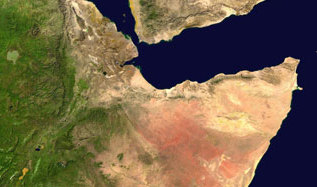PBS: Escaping Eritrea … [Read More...] about ካብ ውሽጢ ቤት ማእሰርታት ኤርትራ
Can the relationship between Europe and Africa stand the test of time?
John Kotsopoulos | March 29, 2017 | The Conversation
The signing of the Treaty of Rome, which established the European Economic Community (EEC) 60 years ago in March 1957, came at a tumultuous time in relations between Europe and Africa.

Just weeks earlier Kwame Nkrumah had declared Ghana a republic, an event which was a turning point in the decolonisation of sub-Saharan Africa.
Nkrumah remarked that the treaty’s inclusion of colonial territories was to neocolonialism what the Berlin Treaty of 1885 had been to colonialism.
He had a point. Two of the six founding members of the EEC – Belgium and France – still held substantial colonial interests on the continent. Accession to the community thus posed the crucial question of what to do about them.
The question became contentious enough to threaten the collapse of the entire Treaty of Rome negotiation process. The other four members of the EEC were Germany, Italy, Luxembourg and the Netherlands.
France in particular was steadfast that its colonies be “associated” with the community. Paris envisaged that its preferential colonial terms of trade would be extended to the entire EEC. But Germany and the Netherlands were opposed, wary of being forced to share the financial and political responsibilities that came with trading with former colonies.
The French argument ultimately won, albeit with some compromises. The treaty’s association agreement would last five years and the preferences France enjoyed from its colonies would be gradually expanded to the rest of the EEC.
The agreement, inscribed into articles 131-136 of the treaty, served as the originator of Europe’s subsequent relationship with the African, Caribbean and Pacific Group of States (ACP). This was codified in the Yaoundé Agreements, the Lomé Convention and today’s Cotonou Agreement. So this 60th anniversary is not just about Europe. The treaty created a framework for multilateral relations between Europe and Africa.
The principles of trade and aid enshrined in the treaty’s association agreement form the basis of Europe’s development agenda in Africa to this day, even though relations have expanded into many more areas in the 21st century.
A common future
The Treaty of Rome laid out the blueprint for the creation of the world’s largest single market. It also contributed to the post World War II process of cooperation and reconciliation in Europe. The push for European unity persisted for 37 years, culminating in the creation of the European Union (EU) under the Maastricht Treaty in 1993.
Although difficult to imagine amid the doom and gloom of Brexit, rising populism and the migration crisis, there is still reason to celebrate when you consider the region’s relationship with Africa. The EU, for all of its troubles, has generally been a progressive partner to Africa, especially with respect to the establishment of the Joint Africa-EU Strategy and the unique programming efforts it has generated.
This of course does not negate instances of neocolonialism, nor the damage done by the clumsy promotion of the European Partnership Agreements (EPAs). The EPAs in particular remain a sore point. Indeed, the preferential trade terms given to African countries by EU member states have been judged discriminatory and in contravention of World Trade Organisation rules.
Beyond the EPA debate, a number of factors have contributed to challenges facing some of the original asymmetries between the two sides. For one, the global South, and China in particular, continues to alter global trade dynamics. African countries and regional organisations now have more trading partners to turn to.
In addition, Africa is in the middle of constructive upheaval, brought on by more than 20 years of robust growth. The Africa of today is not the Africa of 1957. The African Union is also a more robust partner than its predecessor, the Organisation of Africa Unity.
Trade and aid
Back in 1957, the Treaty of Rome laid down the twin principles of EU-Africa relations throughout the 20th century and beyond: trade and aid. These principles were framed within the larger idea of development cooperation. The association agreement provided reciprocal trading arrangements between 31 ‘overseas territories’ – including 18 African ones – and the ECC countries. An overseas development fund was also created, with all six EEC members contributing to it.
Controversially, the agreement served to perpetuate African dependency on Europe. Even the Lome Convention’s much touted “non-reciprocal” principle, which was supposed to nurture African industries, further attached them to Europe. The convention eventually met strong criticism as a system of “collective clientelism”, which was perpetuating dependency and “elite capture” in Africa.
This contradictory relationship between dependency and progressive thinking has made Africans understandably circumspect.
What next for Europe and Africa?
The twin principles of trade and aid still exist. But the growth of the EU-Africa partnership since 2000 – outside of EU-ACP channels – has broadened the relationship into less traditional areas such as science and technology, higher education, private investment, infrastructure and continental integration.
But Kwame Nkurumah’s 1957 criticism is still being levied at the EU today for its alleged neocolonial promotion of the EPAs. Pundits in East and Central Africa have been vociferous in their opposition to the agreements.
However, EU officials have a dramatically different interpretation. The EU Commissioner for International Cooperation and Development, Neven Mimica, described the 2016 EPA with six Southern African Development Community (SADC) members as helping to tap the economic potential of the private sector and increase trade.
With such contrasting perceptions, it is perhaps unsurprising that SADC is the only regional body to have signed an EPA with the EU despite more than 10 years of negotiation. What is crucial is that both sides recognise how far they have come since the Treaty of Rome. And that they accept that a more equitable partnership requires continued commitment to cooperation.
Research Fellow at the Centre for the Study of Governance Innovation, University of Pretoria.
